In a document dated June 30, 1311, preserved in theState Archives of Siena, there is evidence of payment to four musicians of the City of Siena for their services during the transport of a table depicting the Virgin Mary. The reference is to a famous event, documented by chroniclers of the time, that involved the entire Sienese city community: this was the procession organized for the transport of the altarpiece of the Maestà, made by Duccio di Buoninsegna, which was led from the painter’s workshop to the high altar of the Duomo. Another document dated October 9, 1308, attests to the commission of this panel to Duccio by the workman of theOpera di Santa Maria di Siena, and in that text we can also find indications regarding the manner in which the work was carried out and the remuneration for the work.
These are the chronological references for this work, although some scholars have argued that in fact the start of execution may be earlier than the date of 1308, given the size of the work performed. In 1506 the Maestà was moved and Vecchietta’s ciborium was placed on the high altar, while the grandiose Dukes’ altarpiece is attested in 1536 on the altar of St. Sebastian. 1771 is the ill-fated year when the front and back were separated, resulting in the destruction of the original frames and significant damage to the pictorial surface. After being kept for a short time at the Opera House, the two parts were brought back to the cathedral and placed at the altars of St. Ansano and the Blessed Sacrament. The smaller-sized tablets were repaired in the sacristy, but for some the dispersion on the antiques market began. Finally, in 1878 the two large main panels, the two corbels and some parts of the predella were placed in the Museo dell’Opera del Duomo, opened in 1870, and this is still their location today.



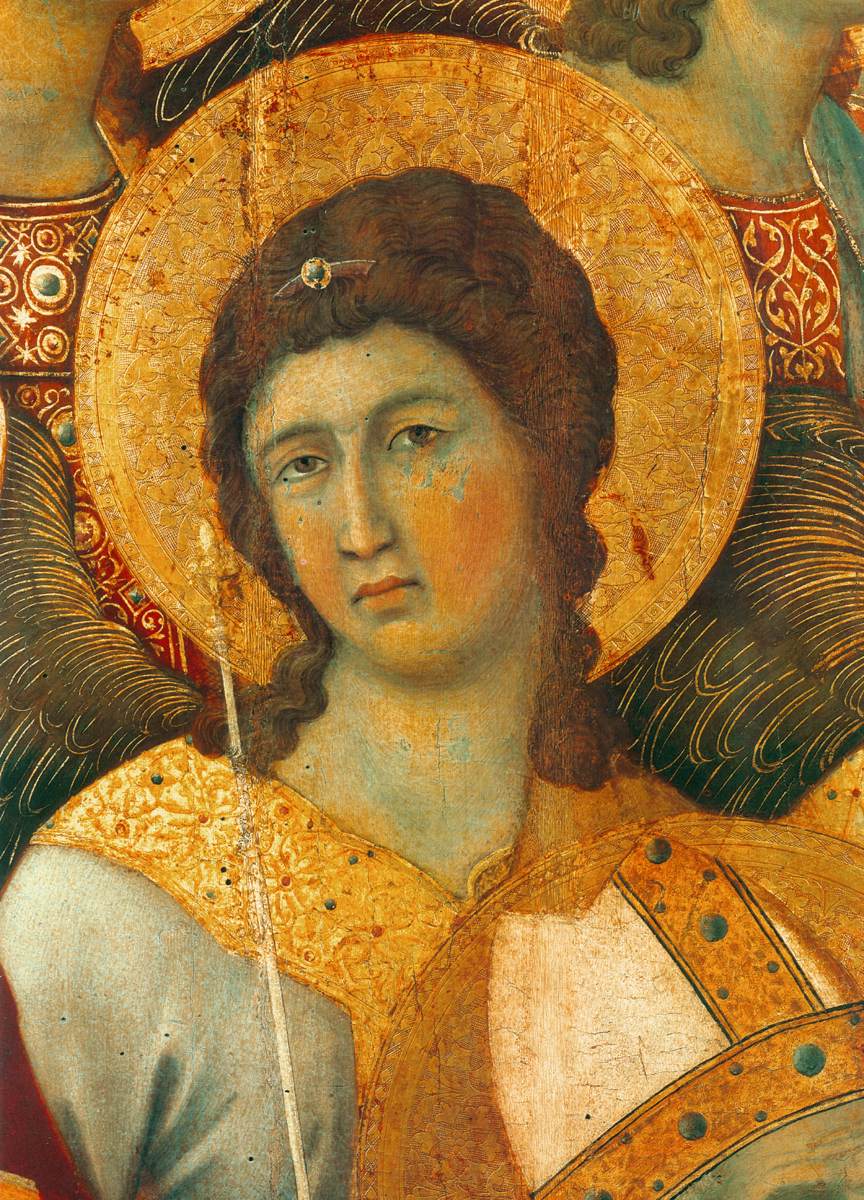
This large altarpiece, more than two meters high and more than four meters wide, can be considered one of the capital works in the history of Italian art. It was an extraordinary feat that was accomplished by Duccio and his workshop, so much so that it earned the painter the inclusion of his name in the invocation to the Virgin found in the lower part of the throne: MATER SANCTA DEI, SIS CAUSA SENIS REQUIEI, SIS DUCIO VITA TE QUIA PINXIT ITA (“Holy Mother of God, be reason for peace for Siena. Be life for Duccio, for he painted you thus.”). This is an important recognition for Duccio because in the invocation his life is equated in importance with peace for the city.
The Maestà was presented as a large altarpiece with a complex structure painted on the front and back. In the main body of the front, which develops horizontally, is depicted the Virgin and Child seated on a marble throne decorated with cosmatesque motifs (this representation is the Maestà proper). Leaning on the throne are a number of angels, whose wide, calm-looking faces are among the most characteristic representations of Duke’s painting. In the foreground, kneeling on either side of the throne, are depicted the four protectors of the city: saint Ansanus, saint Savinus, saint Crescentius, and saint Victor, with an iconography that would become canonical in later Sienese painting. Saint Savinus is depicted as an elderly bishop, the others as knights of different ages. On opposite sides of the composition are the two saints Catherine and Agnes. The other saints and angels surrounding the throne of the Virgin are arranged in three horizontal rows: this is an archaic layout reminiscent of Byzantine theories of saints, in which the heads of the saints, placed side by side, were all aligned. This was a mode that Cimabue had also used in Assisi in the Stories of the Virgin, particularly in theAssumption, painted in the apse of the Upper Basilica of St. Francis.
In the upper part of the panel, ten half-length apostles can still be seen, which were originally contained within a wooden gallery. While the general layout of this frontal part certainly owes much to the Byzantine tradition, observing some elements of this painting it is possible to trace various components of Duccio’s figurative culture. The throne in fact testifies to the Sienese painter’s openness to Giotto’s novelty: it is no longer represented in tralice as in his previous works, but Duccio here tries to intuit frontal perspective, thus contributing to spatial experimentation. Instead, the precious embroidery of the cloth covering the throne is inspired by Gothic models , which is also done for the decoration of St. Catherine’s robe and St. Savino’s cope. This taste for precious decoration would be taken up and extensively developed by Simone Martini. Even the edging of the robes, wavy and elegant, looks to models from beyond the Alps. Looking at the head of the Virgin, one can notice an important iconographic novelty: under the blue mantle there is no longer, to gather the hair, the cap of Byzantine origin. Duccio replaces it for the first time with a light veil, a solution that, adopted immediately in the Sienese sphere, will have great iconographic diffusion and fortune.



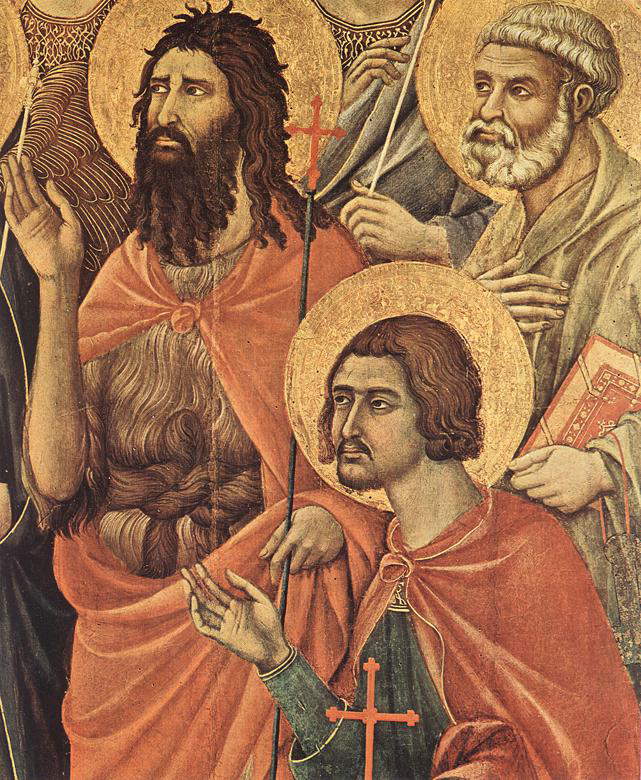
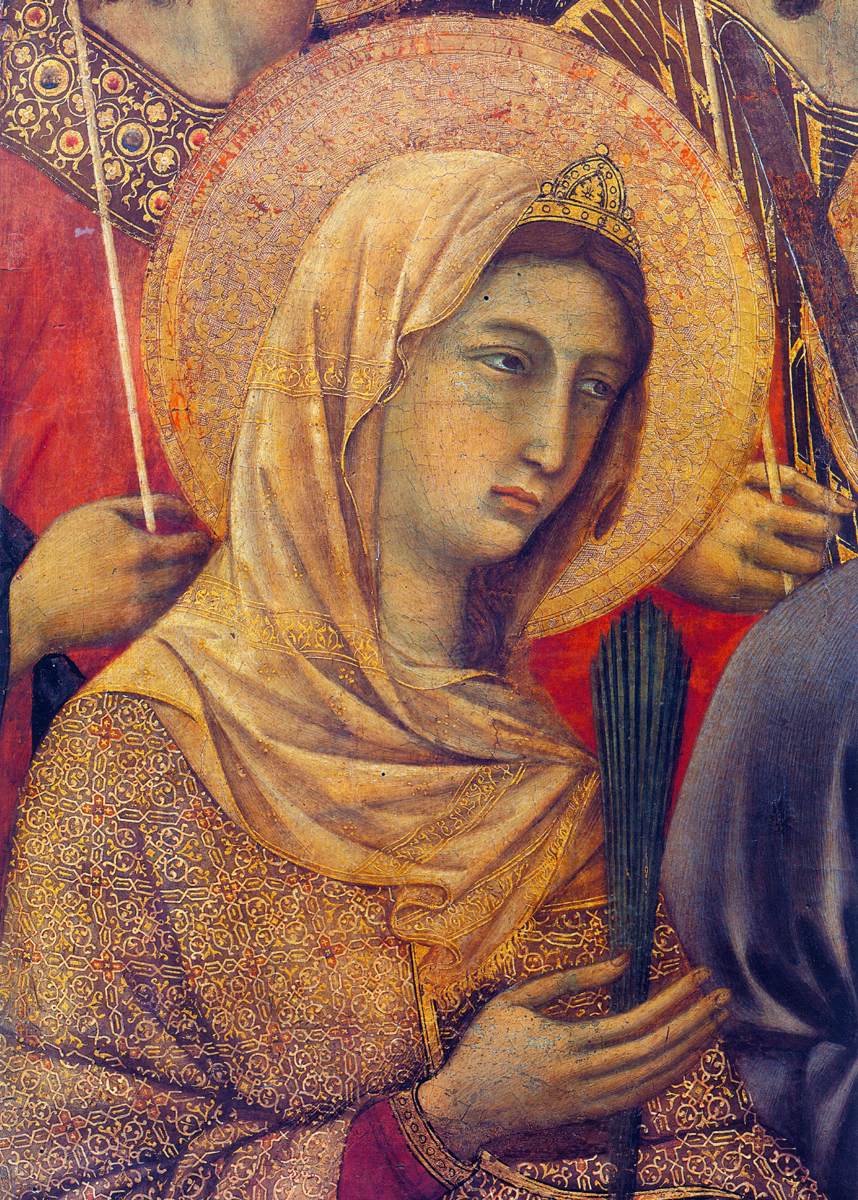


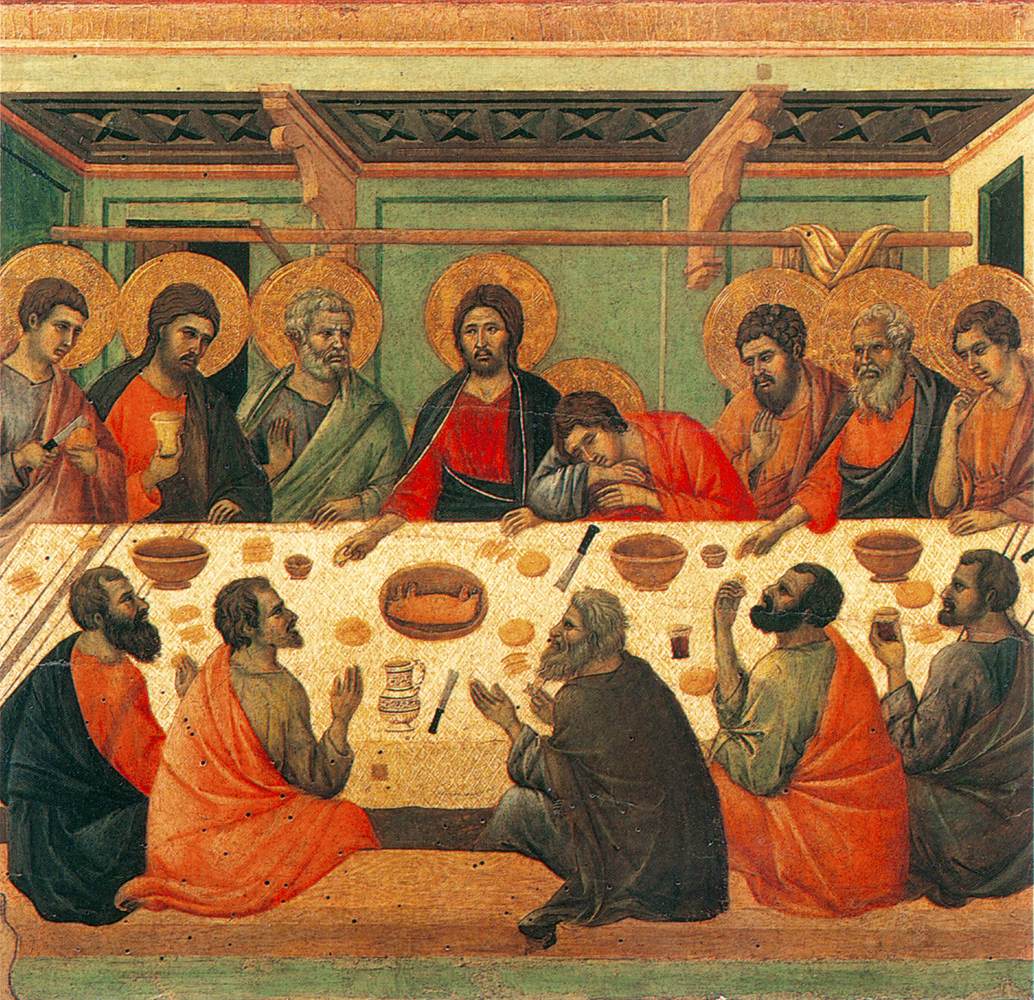

In addition to the central body of the front, there are nearly eighty figurations between predella, coronaments and later figurations. Luciano Bellosi called the storiettes of the Maestà “an admirable garden of colors.” In the tergal part is in fact a large cycle of the Passion, which will serve as a model for many of the later representations of this theme in the environment of Sienese painting. The 26 episodes are organized on two horizontal registers: first we read the one at the bottom, beginning with the Entrance into Jerusalem, then the one at the top. Each register is divided into seven vertical rectangles, each containing two episodes. Containing a single episode are the panels depicting the Entrance into Jerusalem and the Crucifixion, which is also wider than the other scenes: despite the different width of the panels, the characters all retain the same size in each scene. In this side of the Majesty, the narrative aspect of the painting definitely prevails, in which Duccio manifests a great vivacity of observation towards reality, through the representation of contemporary architecture and objects of everyday life, resulting in very detailed scenes. However, it can be observed that there is still a spatial inconsistency in the pictorial representation: a significant example can be found in theLast Supper, where, if the architecture is proposed with an intuitive frontal perspective, as in the throne of the Virgin in the frontal part, the table and the objects resting on it are placed almost vertically, without spatial veracity. The interplay of glances that Duccio creates between the characters participating in the events depicted increases the narrative power of these paintings. The iconographic sources for these stories are the canonical gospels, particularly that of John, but for the Descent into Limbo the use of the apocryphal Gospel of Nicodemus is noteworthy.
Among the most characteristic aspects of Duccio’s painting is a refined and complex capacity for color treatment that makes the subjects he depicts unforgettable. Exemplary is the realization of a chiaroscuro that can be veiled and gives great elegance and delicacy to the figures.
Because of the 18th-century dismemberment of the work and the consequent dispersal of some smaller representations, the physical, and consequently also the iconographic, reconstruction of this monumental altarpiece has been much debated. In particular, the iconographic reconstruction concerns the predella and corbels. In the front part, the predella depicts Stories from the Infancy of Christ and Prophets, while the crowning contains a cycle of the Death and Funeral of the Virgin, of which some scenes are lost and the iconography can only be conjectured. In the back part, the predella contains Episodes from the life and miracles of Christ, while in the crowning there are scenes relating to the Apparitions of Christ after his death.
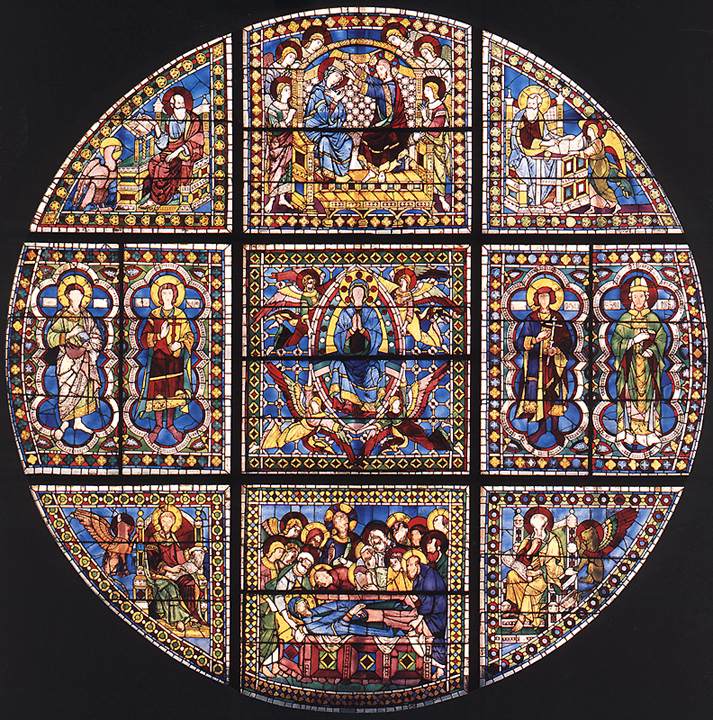

In the biccherna tablet No. 41, dating from 1483, in which the offering of the keys of the city of Siena to the Virgin is depicted, it is possible to recognize the interior of the Cathedral of Siena and some of the works contained therein. Among these, it is possible to identify precisely Duccio’s Maestà: an iron and wooden structure was superimposed on this altarpiece, to which draperies were added, with three angels carved in wood and painted descending toward the officiant and handing the host, chalice and corporal. Four other angels, on the other hand, had the function of candle holders. One can consider this complex a veritable stage machine that made the presence of the altarpiece on the high altar even more spectacular and scenic.
The Maestà altarpiece is not Duccio’s first work for Siena Cathedral: in fact, the cartoon for the circular stained-glass window in the apse is his. The stained-glass window, which in 1943 was removed at the behest of the Soprintendenza ai Monumenti e alle Gallerie di Siena from its original location to preserve it from the damage of the passage of the front during the war, is preserved today in the Museo dell’Opera del Duomo di Siena. The iconographic comparison between the two works allows us to observe an evolution in the group of the city’s patron saints: in fact, Saint Bartholomew is still present in the first work, while in the painting Saint Victor takes the apostle’s place, flanking Saint Ansanus, Saint Savinus and Saint Crescentius, fixing an iconography that would be taken up in later works such as Simone Martini’s Maestà in Siena’s Palazzo Pubblico.
Each patron saint had a dedicated altar inside the cathedral, and beginning in the late 1420s, panels were commissioned for their decoration. The first to be commissioned were those for the altars of Sant’Ansano and San Savino, entrusted to Simone Martini and Pietro Lorenzetti, who made theAnnunciation, together with Lippo Memmi, and the Nativity of the Virgin, respectively. Ambrogio Lorenzetti was later commissioned to paint the altarpiece of the Purification of the Virgin destined for the altar of San Crescenzio, and finally Bartolomeo Bulgarini made the Nativity of Christ for the altar of San Vittore. The choice of the episodes and their dislocation on the altars was designed so that the altarpieces would serve as an introduction to Duccio’s Maestà, which in turn found fulfillment of meaning in theAssumption reproduced in the stained-glass window, in an exquisite iconographic program celebrating the Virgin, protector of the city of Siena.
Warning: the translation into English of the original Italian article was created using automatic tools. We undertake to review all articles, but we do not guarantee the total absence of inaccuracies in the translation due to the program. You can find the original by clicking on the ITA button. If you find any mistake,please contact us.